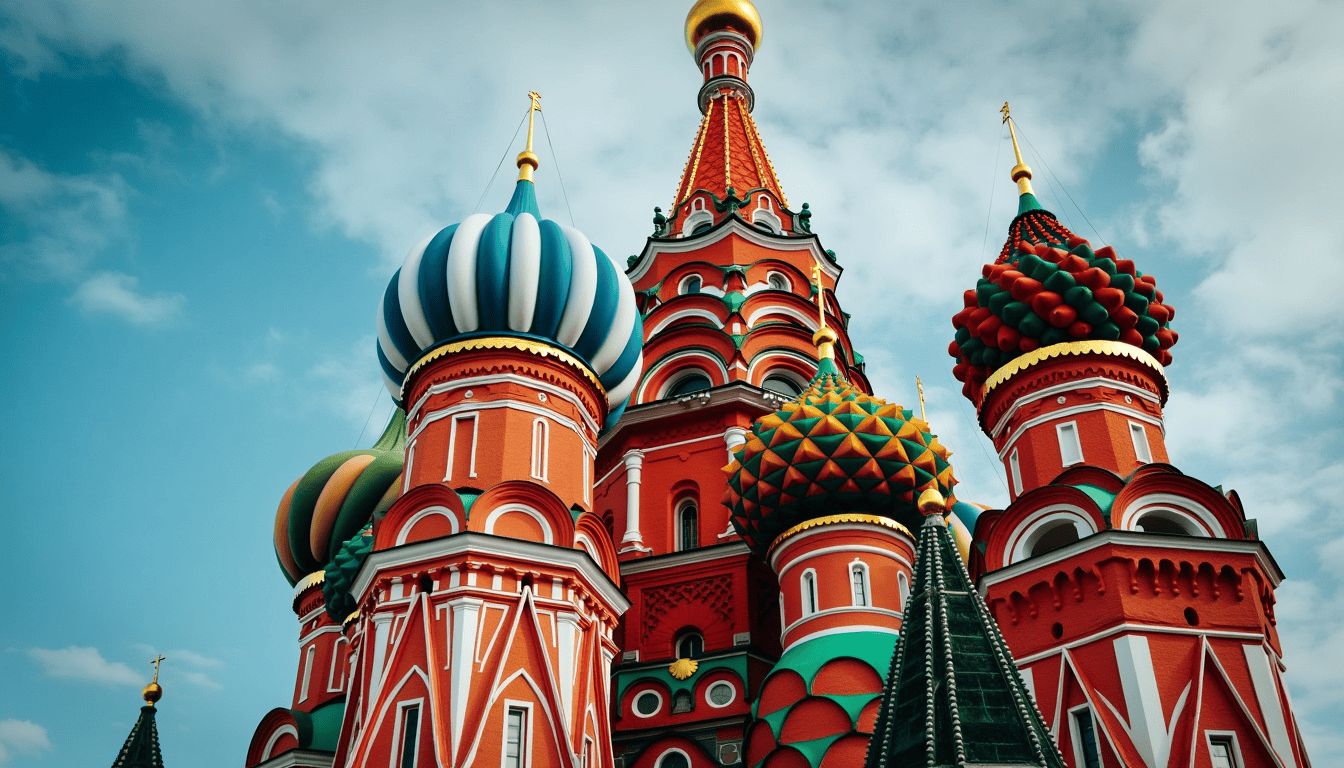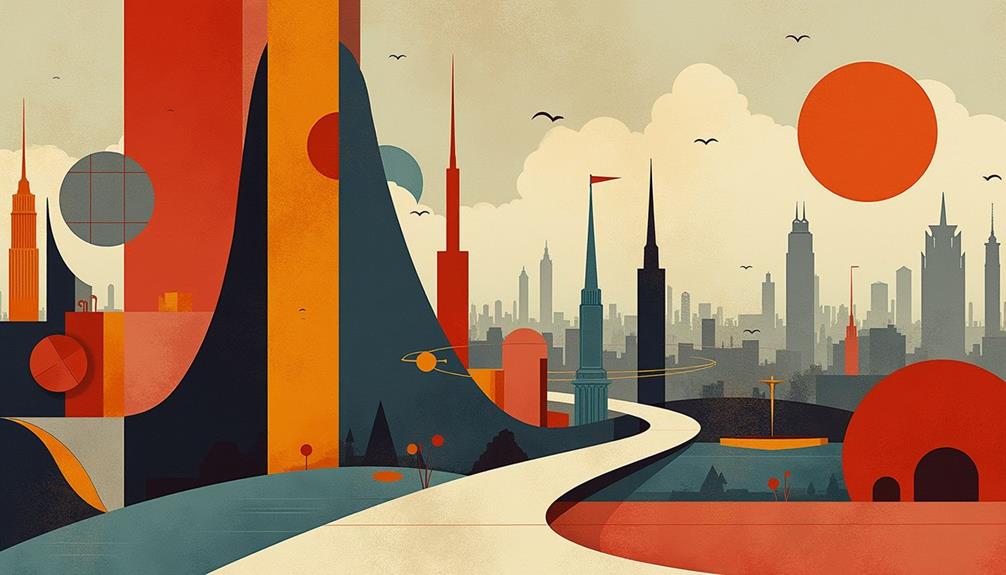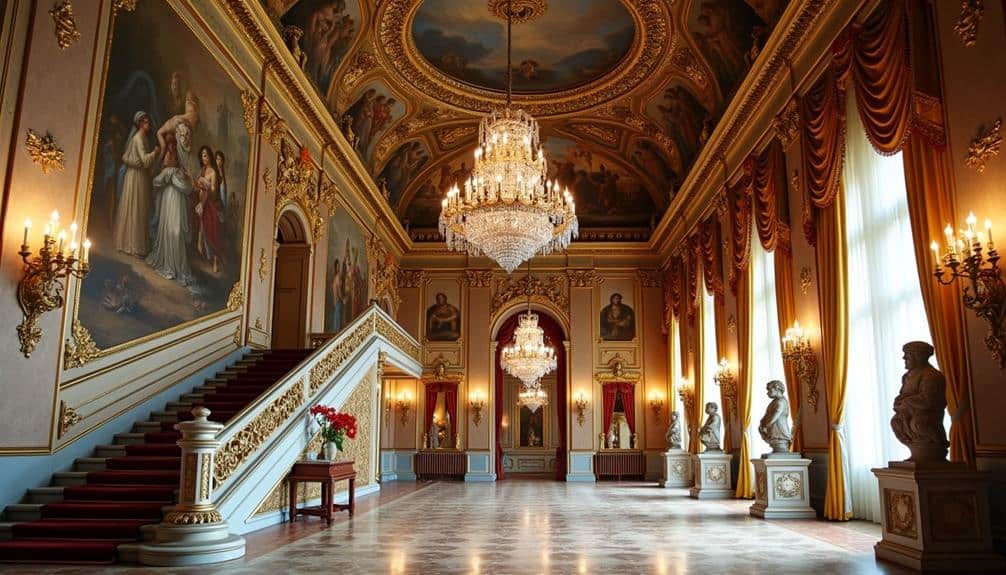Iconic Cathedrals

When you think of Russia’s iconic cathedrals, the vibrant domes of Saint Basil’s Cathedral in Moscow likely come to mind first. These dazzling domes are more than just visually stunning; they’re a powerful symbol of Russia’s rich religious history.
The Kremlin Domes nearby also contribute to this landscape, each one a representation of the spiritual and cultural significance embedded in Russian architecture.
You can’t help but feel a sense of awe and freedom when standing before these majestic structures. The intricate designs and colors of the domes aren’t just for show—they represent deep religious symbolism. Each dome traditionally symbolizes a different Biblical concept or saint, intertwining faith and artistry in a way that’s uniquely Russian.
Walking through these cathedrals, you’ll notice how the architecture guides your eyes upward, a subtle nudge to contemplate the divine. The cathedrals aren’t just buildings; they’re spiritual experiences, inviting you to explore beyond the physical and into the metaphysical.
In a land often defined by its history and politics, these cathedrals stand as timeless sanctuaries, offering a sense of freedom and connection to something greater.
Soviet Architecture
Often overlooked yet profoundly influential, Soviet architecture reshaped the urban landscape across Russia and its former republics. You mightn’t always notice it, but these structures whisper tales of a different era, one dominated by the ideals of socialism and state power.
Soviet architecture, particularly during the mid-20th century, was characterized by its duality: the imposing brutalist structures and the ornate, propagandist socialist realism.
Take a stroll through Moscow or St. Petersburg, and you’ll encounter mighty concrete edifices that embody the brutalist ethos. These buildings, with their stark, functional design, speak to a time when practicality and monumental scale were paramount.
Yet, they’re more than just slabs of concrete; they’re symbols of resilience and collective strength.
On the flip side, socialist realism brought a different flavor. Imagine grandiose buildings adorned with statues and murals celebrating the proletariat.
These structures were designed to inspire and uplift, emphasizing the power and glory of the Soviet state. They aimed to project an image of a utopian society where everyone thrived.
Russian Avant-Garde

Emerging in the early 20th century, the Russian Avant-Garde movement revolutionized art and architecture, pushing the boundaries of creativity and expression.
You’d marvel at how artists and architects threw off conventional constraints, embracing radical new ideas. Central to this movement were the constructivist design and suprematist movement, both of which shattered traditional norms and fostered a spirit of innovation.
Constructivist design, with its emphasis on functionality and materials, encouraged you to see art as a tool for social change. It wasn’t just about aesthetics; it was about practicality and improving lives.
You’d appreciate the bold geometric forms and industrial materials that defined this style, making buildings and artworks that were both beautiful and utilitarian.
Meanwhile, the suprematist movement, led by Kazimir Malevich, focused on pure artistic feeling rather than depicting objects.
Imagine being captivated by abstract shapes and vibrant colors that freed the mind from the familiar and mundane. This was art in its most liberated form.
Traditional Folk Art
While the Russian Avant-Garde movement pushed the boundaries of modernity, traditional folk art remained a steadfast pillar of Russia’s cultural identity. You can’t help but be drawn to the vibrant colors and intricate patterns that define this art form. Folk motifs, deeply rooted in Slavic mythology and daily life, tell stories of freedom, nature, and community.
Imagine walking through a bustling market filled with decorative crafts. You’d see everything from Matryoshka dolls to elaborately painted wooden spoons. Each item isn’t just a piece of art, but a slice of history. Artists use ancient techniques passed down through generations. They often work with natural materials like wood, clay, and fabric, transforming them into masterpieces that capture the essence of rural life.
These crafts aren’t confined to museums; they’re part of everyday life. Folk art is woven into the fabric of Russian culture, from embroidered linens adorning a kitchen table to vibrant murals on village houses.
When you embrace these decorative crafts, you’re not just buying a souvenir; you’re connecting to a rich cultural legacy that champions freedom and creativity. So, let the folk motifs inspire you and celebrate the enduring spirit of Russian tradition.
The Hermitage Museum

Nestled in the heart of St. Petersburg, the Hermitage Museum beckons you to explore its vast collection and rich museum history. As you wander through its grand halls, you’ll be captivated by Hermitage exhibits that span centuries and continents. From ancient artifacts to Renaissance masterpieces, the museum offers a treasure trove for the curious mind.
Founded by Catherine the Great in 1764, the Hermitage started as a private collection but has since grown into one of the largest and most prestigious museums in the world. Its history is a proof of a relentless pursuit of art and culture, a journey that mirrors your own quest for freedom and discovery.
Step into the opulent Winter Palace, one of the Hermitage’s five interconnected buildings, and you’ll feel the weight of history and the thrill of artistic liberation.
The museum’s interiors, adorned with intricate designs and lavish decorations, are works of art themselves, inviting you to lose yourself in a world where creativity knows no bounds.
Whether you’re marveling at a Matisse or contemplating an Egyptian relic, the Hermitage Museum offers an unparalleled experience that fuels your passion for the extraordinary.
Contemporary Innovations
In recent years, Russian art and architecture have embraced contemporary innovations that push the boundaries of creativity and design. You’ll find that digital installations are transforming the way you experience art in museums and public spaces.
These immersive experiences engage all your senses, letting you interact with art in ways you’ve never imagined. It’s a fusion of technology and creativity that invites you to explore new dimensions of artistic expression.
On the architectural front, eco friendly designs are leading the charge towards a sustainable future. Russian architects are reimagining urban landscapes with buildings that blend seamlessly with nature.
They’re incorporating renewable energy sources, green roofs, and recycled materials to create structures that aren’t only beautiful but also kind to the planet. These innovations reflect a commitment to environmental responsibility and a desire to harmonize with the natural world.
You’ll see that contemporary Russian art and architecture are about breaking free from traditional constraints and exploring new possibilities. It’s a movement that celebrates innovation, sustainability, and the limitless potential of human creativity.
When you immerse yourself in these cutting-edge works, you’re not just observing; you’re participating in a revolutionary artistic journey.




